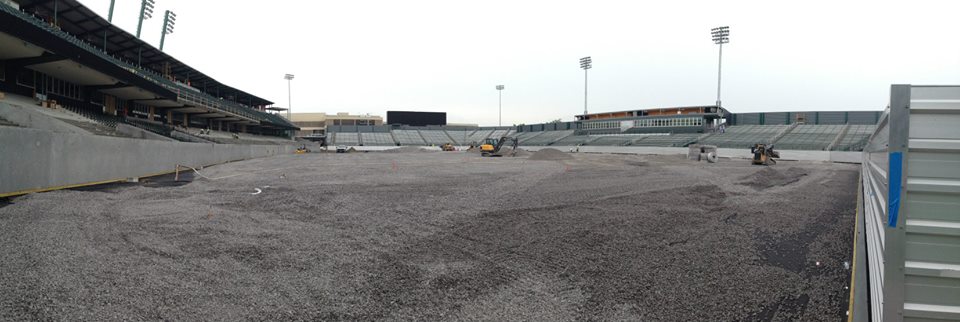During the early 2010s, Tulane University decided it was time to move its football team out of New Orleans’ massive, 73,000+ seat Superdome and build a smaller-scaled field on campus. The 30,000-capacity Yulman Stadium opened in 2014, and its intimate size was fortunate because its chosen location in the University’s athletic quadrangle has been described as “the narrowest point on the campus.”

Green played an essential role in the stadium’s conception — not because Tulane’s teams are called the “Green Wave.” The university mandated that the new stadium’s design and construction align with Green Building Design and Construction Standards and Guidelines. The goal was to achieve Leadership in Energy and Environmental Design (LEED) recognition from the U.S. Green Building Council (USGBC).
“Our approach to LEED has been very practical, emphasizing energy efficiency, water conservation, and indoor air quality,” explained Elizabeth Davey, long-time director of Tulane’s Office of Sustainability. “Then we take other actions on the list that make sense for the project.”
In 2015, Yulman received a Silver LEED, joining its athletic quadrangle neighbor, Hertz Center, Tulane’s basketball and volleyball practice facility, as a LEED honoree.
“It’s not about getting recognized, but doing the right thing,” said Brandon Macneill, Tulane’s then-executive associate athletic director.

The USGBC praised Yulman Stadium for optimizing its water consumption. Installing low-flow toilets, urinals, and aerated faucets lowered water usage by 39%.
With Louisiana being the wettest state in the continental U.S., it was vital for the field to have first-rate drainage and rain-storage systems. Artificial turf, which typically drains better than grass, covers the main football and practice fields. The gravel under Yulman Stadium’s field serves to store rainwater.
To further decrease the chance of flooding, an underground storage system captures most of the stormwater underneath the practice field, slowing down the water heading to New Orleans’ drainage and pumping network. This system has earned Tulane’s first LEED credit for managing stormwater quantity. At the entry plaza, a rain garden composed of native grasses and cypress trees also diminishes the threat of flooding by absorbing stormwater.

The USGBC also applauded how the stadium optimized its energy performance. The software employed during the design stage targeted ways to decrease energy consumption. An automated system controls the HVAC and other building systems.
The concourses also contain LEDs, and the stadium lights are also energy-efficient. Lighting levels throughout the field are adjustable by the time of day and the activities happening, minimizing energy waste. Likewise, the design emphasizes natural light wherever possible, while overhangs provide shade from the sun’s glare.
Yulman’s construction stressed sustainability. “Of the total cost of materials,” Davy revealed, “48% was spent on materials produced in our region, and 39% was spent on materials made from recycled content.”
Builders incorporated several small existing structures into the stadium instead of being demolished. USGBC recognized the construction team’s superb use of recycled and locally-sourced materials with LEED “innovation in design” credits. The builders also prioritized measures to maintain good indoor air quality, such as protecting HVAC equipment and building materials from the elements.

Containers for recycling cans and bottles were placed by trash cans inside Yulman Stadium and by stadium entryways and public spaces to promote recycling among Green Wave fans.
According to Davy, “ Tulane averaged about 1.2 tons of recycling each Game Day during Yulman’s first season.”
Recycling remains a focal point at the stadium. Throughout the seasons, student volunteer organizations have worked to encourage recycling in the tailgating area and near stadium entrances. Recycling containers were also placed in Tailgate Village.
The stadium’s construction did cause some concern from those living in this predominantly residential neighborhood. Field lighting was arranged to restrict spillage outside the stadium, while screening was erected to buffer sound to address noise and light pollution worries. The project’s design also lowered the westside seating bowl and scaled the structure’s four sides to make its presence less intrusive to this low-rise surrounding area.
Yulman Stadium isn’t just a sports facility employed six times a year for football games. It’s also used daily as a teaching location and gathering place for Tulane’s Athletic and Student Life departments.





